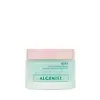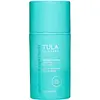What's inside
What's inside
 Key Ingredients
Key Ingredients

 Benefits
Benefits

 Concerns
Concerns

 Ingredients Side-by-side
Ingredients Side-by-side

Glycerin
HumectantWater
Skin ConditioningSodium Cocoyl Glycinate
CleansingPropanediol
SolventKaolin
AbrasiveLactococcus Ferment Lysate
Skin ConditioningBentonite
AbsorbentMagnesium Aluminum Silicate
AbsorbentMaltooligosyl Glucoside
Skin ConditioningMyristic Acid
CleansingLactic Acid
BufferingGlyceryl Stearate
EmollientParachlorella Beijerinckii Exopolysaccharides
Skin ProtectingChlorella Vulgaris Extract
Skin ConditioningAlteromonas Ferment Extract
Skin ConditioningCorallina Officinalis Extract
Skin ConditioningCurcuma Longa Root Extract
MaskingMelia Azadirachta Leaf Extract
Skin ConditioningMelia Azadirachta Flower Extract
Skin ConditioningOcimum Basilicum Flower/Leaf Extract
TonicOcimum Sanctum Leaf Extract
Skin ConditioningTocopherol
AntioxidantHydrogenated Starch Hydrolysate
HumectantSodium Lauroyl Methyl Isethionate
CleansingCocamidopropyl Betaine
CleansingSodium Methyl Oleoyl Taurate
CleansingButylene Glycol
HumectantCoco-Glucoside
CleansingLauryl Glucoside
CleansingStyrene/Acrylates Copolymer
Phytosteryl/Octyldodecyl Lauroyl Glutamate
Skin ConditioningEthylhexylglycerin
Skin ConditioningLauric Acid
CleansingPalmitic Acid
EmollientCellulose Gum
Emulsion StabilisingSucrose
HumectantSodium Chloride
MaskingMica
Cosmetic ColorantSodium Benzoate
MaskingPhenoxyethanol
PreservativeCI 77891
Cosmetic ColorantCI 77491
Cosmetic ColorantCI 77742
Cosmetic ColorantCI 77289
Cosmetic ColorantGlycerin, Water, Sodium Cocoyl Glycinate, Propanediol, Kaolin, Lactococcus Ferment Lysate, Bentonite, Magnesium Aluminum Silicate, Maltooligosyl Glucoside, Myristic Acid, Lactic Acid, Glyceryl Stearate, Parachlorella Beijerinckii Exopolysaccharides, Chlorella Vulgaris Extract, Alteromonas Ferment Extract, Corallina Officinalis Extract, Curcuma Longa Root Extract, Melia Azadirachta Leaf Extract, Melia Azadirachta Flower Extract, Ocimum Basilicum Flower/Leaf Extract, Ocimum Sanctum Leaf Extract, Tocopherol, Hydrogenated Starch Hydrolysate, Sodium Lauroyl Methyl Isethionate, Cocamidopropyl Betaine, Sodium Methyl Oleoyl Taurate, Butylene Glycol, Coco-Glucoside, Lauryl Glucoside, Styrene/Acrylates Copolymer, Phytosteryl/Octyldodecyl Lauroyl Glutamate, Ethylhexylglycerin, Lauric Acid, Palmitic Acid, Cellulose Gum, Sucrose, Sodium Chloride, Mica, Sodium Benzoate, Phenoxyethanol, CI 77891, CI 77491, CI 77742, CI 77289
Water
Skin ConditioningGlycerin
HumectantOctyldodecyl Neopentanoate
EmollientPyrus Malus Fruit Extract
Skin ConditioningButylene Glycol
HumectantEthylhexyl Palmitate
EmollientCetearyl Alcohol
EmollientAlaria Esculenta Extract
Skin ProtectingOpuntia Ficus-Indica Stem Extract
Skin ConditioningLactococcus Ferment Lysate
Skin ConditioningLactic Acid
BufferingCoco-Glucoside
CleansingPEG-8
HumectantPropylene Glycol Stearate
Skin ConditioningKluyveromyces/Lactobacillus/Lactococcus/Leuconostoc/Saccharomyces Milk Ferment Filtrate
Skin ConditioningPEG-60 Hydrogenated Castor Oil
EmulsifyingPropylene Glycol Laurate
Skin ConditioningCaprylic/Capric Triglyceride
MaskingEthylhexylglycerin
Skin ConditioningMyristyl Alcohol
EmollientLauryl Alcohol
EmollientCetyl Alcohol
EmollientTocopheryl Acetate
AntioxidantCarbomer
Emulsion StabilisingPalmitic Acid
EmollientStearic Acid
CleansingLecithin
EmollientPolysorbate 20
EmulsifyingBehenyl Alcohol
EmollientAcrylates/C10-30 Alkyl Acrylate Crosspolymer
Emulsion StabilisingOctyldodecanol
EmollientCeramide Ng
Skin ConditioningSorbitan Laurate
EmulsifyingDisodium EDTA
Sodium Hydroxide
BufferingSodium Chloride
MaskingSodium Benzoate
MaskingGlyceryl Stearate
EmollientPhenoxyethanol
PreservativeParfum
MaskingMica
Cosmetic ColorantCI 77891
Cosmetic ColorantWater, Glycerin, Octyldodecyl Neopentanoate, Pyrus Malus Fruit Extract, Butylene Glycol, Ethylhexyl Palmitate, Cetearyl Alcohol, Alaria Esculenta Extract, Opuntia Ficus-Indica Stem Extract, Lactococcus Ferment Lysate, Lactic Acid, Coco-Glucoside, PEG-8, Propylene Glycol Stearate, Kluyveromyces/Lactobacillus/Lactococcus/Leuconostoc/Saccharomyces Milk Ferment Filtrate, PEG-60 Hydrogenated Castor Oil, Propylene Glycol Laurate, Caprylic/Capric Triglyceride, Ethylhexylglycerin, Myristyl Alcohol, Lauryl Alcohol, Cetyl Alcohol, Tocopheryl Acetate, Carbomer, Palmitic Acid, Stearic Acid, Lecithin, Polysorbate 20, Behenyl Alcohol, Acrylates/C10-30 Alkyl Acrylate Crosspolymer, Octyldodecanol, Ceramide Ng, Sorbitan Laurate, Disodium EDTA, Sodium Hydroxide, Sodium Chloride, Sodium Benzoate, Glyceryl Stearate, Phenoxyethanol, Parfum, Mica, CI 77891
Ingredients Explained
These ingredients are found in both products.
Ingredients higher up in an ingredient list are typically present in a larger amount.
Butylene Glycol (or BG) is used within cosmetic products for a few different reasons:
Overall, Butylene Glycol is a safe and well-rounded ingredient that works well with other ingredients.
Though this ingredient works well with most skin types, some people with sensitive skin may experience a reaction such as allergic rashes, closed comedones, or itchiness.
Learn more about Butylene GlycolCi 77891 is a white pigment from Titanium dioxide. It is naturally found in minerals such as rutile and ilmenite.
It's main function is to add a white color to cosmetics. It can also be mixed with other colors to create different shades.
Ci 77891 is commonly found in sunscreens due to its ability to block UV rays.
Learn more about CI 77891Coco-Glucoside is a surfactant, or a cleansing ingredient. It is made from glucose and coconut oil.
Surfactants help gather dirt, oil, and other pollutants from your skin to be rinsed away.
This ingredient is considered gentle and non-comedogenic. However, it may still be irritating for some.
Learn more about Coco-GlucosideEthylhexylglycerin (we can't pronounce this either) is commonly used as a preservative and skin softener. It is derived from glyceryl.
You might see Ethylhexylglycerin often paired with other preservatives such as phenoxyethanol. Ethylhexylglycerin has been found to increase the effectiveness of these other preservatives.
Glycerin is already naturally found in your skin. It helps moisturize and protect your skin.
A study from 2016 found glycerin to be more effective as a humectant than AHAs and hyaluronic acid.
As a humectant, it helps the skin stay hydrated by pulling moisture to your skin. The low molecular weight of glycerin allows it to pull moisture into the deeper layers of your skin.
Hydrated skin improves your skin barrier; Your skin barrier helps protect against irritants and bacteria.
Glycerin has also been found to have antimicrobial and antiviral properties. Due to these properties, glycerin is often used in wound and burn treatments.
In cosmetics, glycerin is usually derived from plants such as soybean or palm. However, it can also be sourced from animals, such as tallow or animal fat.
This ingredient is organic, colorless, odorless, and non-toxic.
Glycerin is the name for this ingredient in American English. British English uses Glycerol/Glycerine.
Learn more about GlycerinGlyceryl Stearate is a mix of glycerin and stearic acid.
It is used to stabilize the mixing of water and oil ingredients. By preventing these ingredients from separating, it can help elongate shelf life. It can also help thicken the product's texture.
As an emollient, it helps soften skin and supports barrier-replenishing ingredients.
In cosmetics, Glyceryl Stearate is often made from vegetable oils or synthetically produced.
This ingredient may not be fungal-acne safe
Fun fact: The human body also creates Glyceryl Stearate naturally.
Learn more about Glyceryl StearateLactic Acid is another well-loved alpha hydroxy acid (AHA). It is gentler than glycolic acid but still highly effective.
Its main role is to exfoliate the surface of the skin by loosening the “glue” that holds dead skin cells together. Shedding those old cells leads to smoother, softer, and more even-toned skin.
Because lactic acid molecules are larger than glycolic acid, they don’t penetrate as deeply. This means they’re less likely to sting or irritate, making it a great choice for beginners or those with sensitive skin.
Like glycolic acid, it can:
Lactic acid also acts as a humectant (like hyaluronic acid). It can draw water into the skin to improve hydration and also plays a role in the skin's natural moisturizing factor (NMF) in the form of sodium lactate.
Studies show it can boost ceramide production to strengthen the skin barrier and even help balance the skin’s microbiome.
To get results, choose products with a pH between 3-4.
Lower strengths (5-12%) focus on surface exfoliation; higher strengths (12% and up) can reach deeper in the dermis (deeper, supportive layer) to improve skin texture and firmness over time.
Though it was originally derived from milk, most modern lactic acid used in skincare is vegan. It is made through non-dairy fermentation to create a bio-identical and stable form suitable for all formulations.
When lactic acid shows up near the end of an ingredient list, it usually means the brand added just a tiny amount to adjust the product’s pH.
Legend has it that Cleopatra used to bathe in sour milk to help reduce wrinkles.
Lactic acid is truly a gentle multitasker: it exfoliates, hydrates, strengthens, and brightens. It's a great ingredient for giving your skin a smooth, glowing, and healthy look without the harshness of stronger acids.
Read more about some other popular AHA's here:
Learn more about Lactic AcidLactococcus Ferment Lysate is a postbiotic created by fermenting Lactoccus lactis, a type of bacteria more commonly used to create Lactic acid.
Postbiotics are inactive molecules produced by probiotic bacteria that provide skin benefits.
This ingredient offers promising benefits, but it is relatively new and more evidence is needed to prove its efficacy. The manufacturer claims this ingredient:
A study from 2022 found this ingredient helped protect skin against damaged from UV exposure (though this should not replace your sunscreen!).
The lysate in the ingredient name refers to a fluid that forms from breaking down the cell membrane.
Learn more about Lactococcus Ferment LysateMica is a naturally occurring mineral used to add shimmer and color in cosmetics. It can also help improve the texture of a product or give it an opaque, white/silver color.
Serecite is the name for very fine but ragged grains of mica.
This ingredient is often coated with metal oxides like titanium dioxide. Trace amounts of heavy metals may be found in mica, but these metals are not harmful in our personal products.
Mica has been used since prehistoric times throughout the world. Ancient Egyptian, Indian, Greek, Roman, Aztec, and Chinese civilizations have used mica.
Learn more about MicaPalmitic Acid is a fatty acid naturally found in our skin and in many plant and animal sources. In cosmetics, it is usually derived from palm oil. It serves many purposes in skincare, acting as a cleanser, emollient, and emulsifier.
As an emollient, palmitic acid helps soften and smooth the skin by preventing water loss. In cleansers, it helps remove oil and dirt while creating foam.
Its emulsifying properties help stabilize products by keeping water and oil-based ingredients from separating.
This may not be suitable for fungal acne-prone skin, as fatty acids like this can sometimes trigger breakouts in sensitive individuals.
Learn more about Palmitic AcidPhenoxyethanol is a preservative that has germicide, antimicrobial, and aromatic properties. Studies show that phenoxyethanol can prevent microbial growth. By itself, it has a scent that is similar to that of a rose.
It's often used in formulations along with Caprylyl Glycol to preserve the shelf life of products.
Sodium Benzoate is a preservative. It's used in both cosmetic and food products to inhibit the growth of mold and bacteria. It is typically produced synthetically.
Both the US FDA and EU Health Committee have approved the use of sodium benzoate. In the US, levels of 0.1% (of the total product) are allowed.
Sodium benzoate works as a preservative by inhibiting the growth of bacteria inside of cells. It prevents the cell from fermenting a type of sugar using an enzyme called phosphofructokinase.
It is the salt of benzoic acid. Foods containing sodium benzoate include soda, salad dressings, condiments, fruit juices, wines, and snack foods.
Studies for using ascorbic acid and sodium benzoate in cosmetics are lacking, especially in skincare routines with multiple steps.
We always recommend speaking with a professional, such as a dermatologist, if you have any concerns.
Learn more about Sodium BenzoateChances are, you eat sodium chloride every day. Sodium Chloride is also known as table salt.
This ingredient has many purposes in skincare: thickener, emulsifier, and exfoliator.
You'll most likely find this ingredient in cleansers where it is used to create a gel-like texture. As an emulsifier, it also prevents ingredients from separating.
There is much debate on whether this ingredient is comedogenic. The short answer - comedogenic ratings don't tell the whole story. Learn more about comegodenic ratings here.
The concensus about this ingredient causing acne seems to be divided. Research is needed to understand if this ingredient does cause acne.
Scrubs may use salt as the primary exfoliating ingredient.
Learn more about Sodium ChlorideWater. It's the most common cosmetic ingredient of all. You'll usually see it at the top of ingredient lists, meaning that it makes up the largest part of the product.
So why is it so popular? Water most often acts as a solvent - this means that it helps dissolve other ingredients into the formulation.
You'll also recognize water as that liquid we all need to stay alive. If you see this, drink a glass of water. Stay hydrated!
Learn more about Water